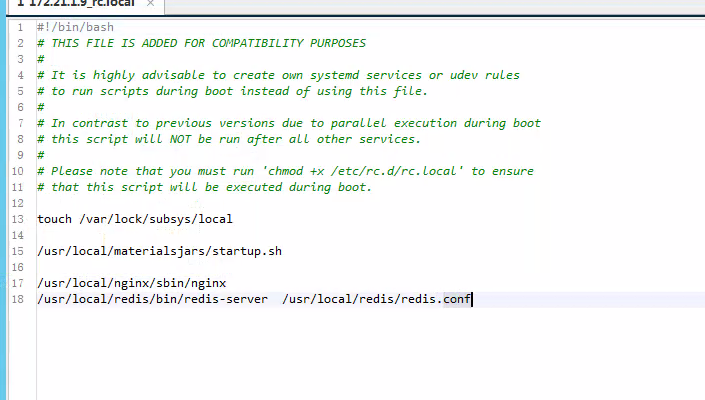nginx设置开机自启动
1、路径下启动:./nginx 配置更改后重启:./nginx -s reload
2、指定配置文件启动 /usr/local/nginx/sbin/nginx -c /usr/local/nginx/conf/nginx.conf
3、指定配置文件重启 /usr/local/nginx/sbin/nginx -s reload -c /usr/local/nginx/conf/nginx.conf
一、普通方法(不建议)
在/etc/init.d下创建文件nginx
[root@localhost ~]# vim /etc/init.d/nginx
参考内容如下:
#!/bin/sh
# nginx - this script starts and stops the nginx daemon
# chkconfig: - 85 15
# description: NGINX is an HTTP(S) server, HTTP(S) reverse
# proxy and IMAP/POP3 proxy server
# processname: nginx
# config: /etc/nginx/nginx.conf
# config: /etc/sysconfig/nginx
# pidfile: /var/run/nginx.pid
# Source function library.
. /etc/rc.d/init.d/functions
# Source networking configuration.
. /etc/sysconfig/network
# Check that networking is up.
[ "$NETWORKING" = "no" ] && exit 0
nginx="/mnt/nginx/sbin/nginx"
prog=$(basename $nginx)
NGINX_CONF_FILE="/mnt/nginx/nginx.conf"
[ -f /etc/sysconfig/nginx ] && . /etc/sysconfig/nginx
lockfile=/var/lock/subsys/nginx
make_dirs() {
# make required directories
user=`$nginx -V 2>&1 | grep "configure arguments:" | sed 's/[^*]*--user=\([^ ]*\).*/\1/g' -`
if [ -z "`grep $user /etc/passwd`" ]; then
useradd -M -s /bin/nologin $user
fi
options=`$nginx -V 2>&1 | grep 'configure arguments:'`
for opt in $options; do
if [ `echo $opt | grep '.*-temp-path'` ]; then
value=`echo $opt | cut -d "=" -f 2`
if [ ! -d "$value" ]; then
# echo "creating" $value
mkdir -p $value && chown -R $user $value
fi
fi
done
}
start() {
[ -x $nginx ] || exit 5
[ -f $NGINX_CONF_FILE ] || exit 6
make_dirs
echo -n $"Starting $prog: "
daemon $nginx -c $NGINX_CONF_FILE
retval=$?
echo
[ $retval -eq 0 ] && touch $lockfile
return $retval
}
stop() {
echo -n $"Stopping $prog: "
killproc $prog -QUIT
retval=$?
echo
[ $retval -eq 0 ] && rm -f $lockfile
return $retval
}
restart() {
configtest || return $?
stop
sleep 1
start
}
reload() {
configtest || return $?
echo -n $"Reloading $prog: "
killproc $nginx -HUP
RETVAL=$?
echo
}
force_reload() {
restart
}
configtest() {
$nginx -t -c $NGINX_CONF_FILE
}
rh_status() {
status $prog
}
rh_status_q() {
rh_status >/dev/null 2>&1
}
case "$1" in
start)
rh_status_q && exit 0
$1
;;
stop)
rh_status_q || exit 0
$1
;;
restart|configtest)
$1
;;
reload)
rh_status_q || exit 7
$1
;;
force-reload)
force_reload
;;
status)
rh_status
;;
condrestart|try-restart)
rh_status_q || exit 0
;;
*)
echo $"Usage: $0 {start|stop|status|restart|condrestart|try-restart|reload|force-reload|configtest}"
exit 2
esac注意配置:
nginx="/usr/local/nginx/sbin/nginx" //修改成nginx执行程序的路径 NGINX_CONF_FILE="/usr/local/nginx/conf/nginx.conf" //修改成nginx.conf文件的路径
设置文件的权限
[root@localhost ~]# chmod a+x /etc/init.d/nginx //
至此就可以通过指令控制启动停止
/etc/init.d/nginx start
/etc/init.d/nginx stop
上面的方法完成了使用脚本管理nginx服务的功能,但还是不太方便。
将nginx服务加入chkconfig管理列表:
[root@localhost ~]# chkconfig --add /etc/init.d/nginx
加完之后就可以使用service对nginx进行启动/停止/重启等操作了:
service nginx start
service nginx stop
service nginx restart
最后设置开机自动启动:
[root@localhost ~]# chkconfig nginx on
二、简单方法(推荐)
在/etc/rc.d/rc.local中添加nginx启动命令行:
/usr/local/nginx/sbin/nginx
如下图所示:

赋权:
chmod +x /etc/rc.d/rc.local
重启reboot即可




